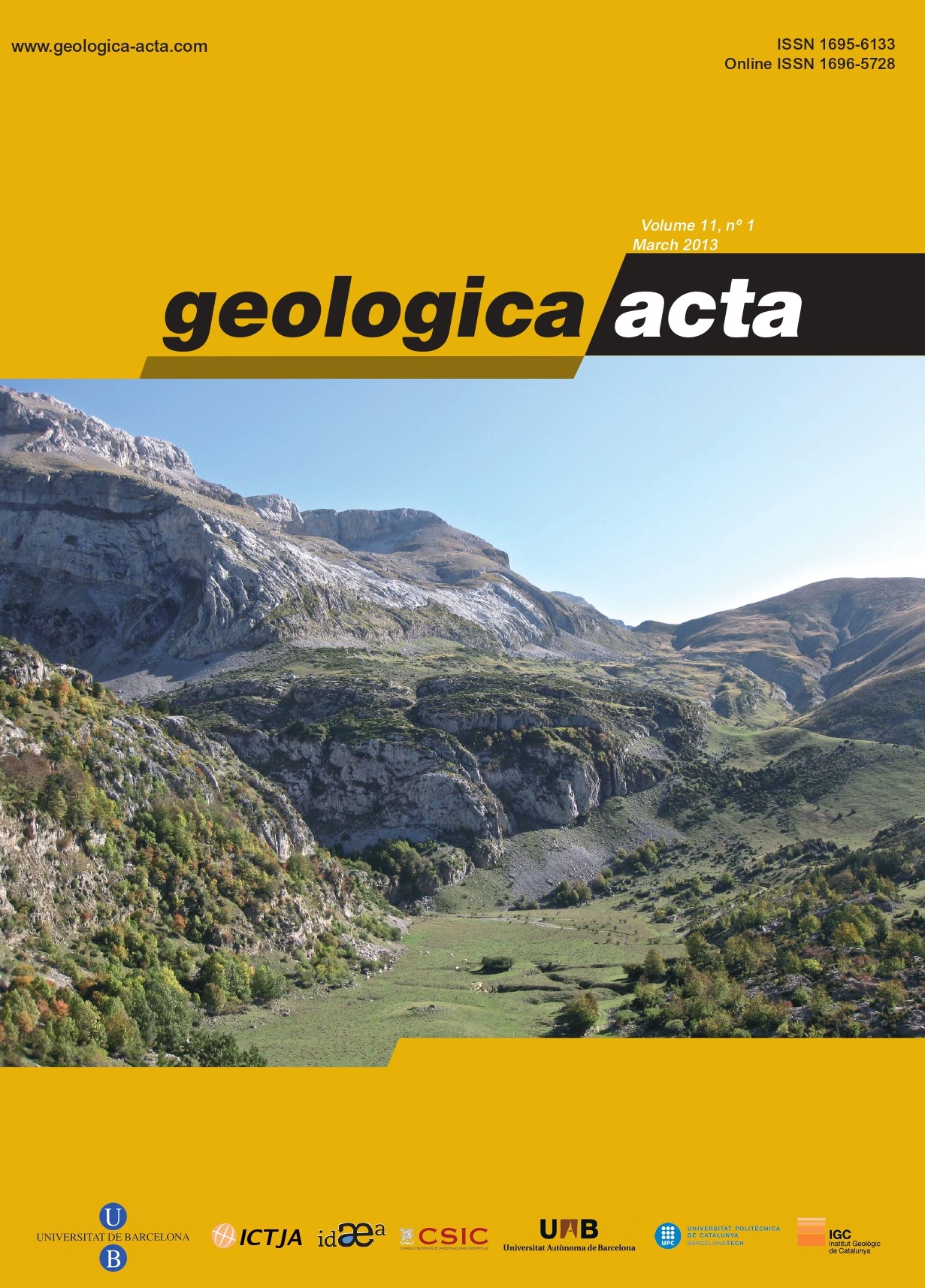An accurate record of volcanic ash fall deposition as characterized by dispersed organic matter in a lower Permian tonstein layer (Faxinal Coalfield, Paraná Basin, Brazil)
DOI:
https://doi.org/10.1344/105.000001835Keywords:
Tonstein, Organic matter, Volcanic ash fall, Southern Paraná BasinAbstract
For the first time, the dispersed organic matter in the tonstein layer interbedded with a coal seam in the Faxinal Coalfield (Sakmarian, Southern Paraná Basin, Brazil) is characterized. The deposition of clusters of pollen grains was highly influenced by the intense ash fall process that probably occurred during seasonal dehiscence of reproductive structures. The well-preserved phytoclasts with their upper and lower leaf cuticles stuck together indicate that the rapid fall of ash on this material hindered organic biodegradation. The preservation of seemingly autochthonous Botryococcus colonies at the top of the tonstein layer is evidence of the subaqueous deposition of this layer. The darkening in cuticles and xylem phytoclasts can be attributed to different causes: the thermal influence of ash fall during deposition, chemical effects of the ash, prolonged oxidation of organic matter in low water level conditions or the burning of plant organs by wildfires. Analyses of dispersed organic matter along the tonstein layer showed that the organic matter succession reflects the composition of different plant strata (herbaceous pteridophytes and arboreal glossopterids-cordaitaleans) around the deposition site.
References
Alves, R.G., Ade, M.V.B., 1996. Sequence stratigraphy and organic petrography applied to the study of Candiota coalfield, RS, South Brazil. International Journal of Coal Geology, 30, 231-248.
Batten, D.J., Lister, J.K., 1988. Evidence of freshwater dinoflagellates and other algae in the English Wealden (Early Cretaceous). Cretaceous Research, 9, 171-179.
Bohor, B.F., Triplehorn, D.M., 1993. Tonsteins: Altered VolcanicAsh Layers in Coal-bearing Sequences. Geological Society of America, 285 (Special Paper), 42pp.
Bouroz, A., 1962. Sur la pluralite d’origine des tonsteins: Société Géologique du Nord. Annales, 82, 77-94.
Burnham, R.J., Spicer, R.A., 1986. Forest Litter Preserved by Volcanic Activity at El Chichón, Mexico: A Potentially Accurate Record of the Pre-Eruption Vegetation. Palaios, 1(2), 158-161.
Caratini, C., Bellet, J., Tissot, C., 1983. Les palynofaciès: representation graphique, interêt de leur etude pour les reconstitutions paléogéographiques. In: (ed) Centre National de la Recherche Scientifique. Paris, Géochimie Organique des Sédiments Marins d’Orgon à Misedor, 327-351.
Cazzulo-Klepzig, M., Guerra-Sommer, M., Menegat, R., Simas, M.W., Mendonça Filho, J.G., 2007. Peat-forming environment of Permian coal seams from the Faxinal coalfield (Paraná Basin) in southern Brazil, based on palynology and palaeobotany. Revista Brasileira de Paleontologia, 10(2), 117-127.
Chandra, S., Srivastava, A.K., 1981. A new species of Glossopteris from the Barakar Formation or Lower Gondwana of India.
The Paleobotanist, 27(2), 166-73.
Claret, J., Jardine, S., Robert, P., 1981. La diversité des roches mères pétrolières: aspects géologiques et implications économiques à partir de quatre exemples. Bulletin dês Centres Recherche Exploration-Production Elf-Aquitaine, 5, 383-417.
Cole, J.M., 1987. Some fresh/brackish water depositional environments in the S.E. Asian Tertiary with emphasis on coal- bearing and lacustrine deposits and their source rock potential. Proceedings of the Indonesian Petroleum Association, 16, 429-449.
Combaz, A., 1964. Les palynofacies. Revue de Micropaléontologie, 7, 205-218.
Combaz, A., 1980. Les kérogènes vus au microscope. In: Durand, B. (ed.). Kerogen: Insoluble organic matter in sedimentary
rocks. Paris, Technip, 55-111.
Cook, R.J., Barron, J.C., Papendick, G.J., Willians, G.J.III, 1981. Impact on Agriculture of the Mount St. Helens Eruptions. Science, 211(4477), 16-22.
Corrêa da Silva, Z.C., 1973. On “Tonstein” in Candiota Mine, Río Grande do Sul, Brazil. Compte Rendu, Krefeld. 7th Congrès
International de Géologie Stratigraphie Carbonifère, 2, 287-297.
Corrêa da Silva, Z.C., 1991. The formation of coal deposits in South Brazil. Gondwana 7 Universidade de São Paulo( USP), São Paulo, Proceedings, 233-252.
Coutinho, J.M.V., Hachiro, J., 2005. Distribution, mineralogy, petrography, provenance and significance of Permian ashcarrying deposits in the Paraná Basin. Revista do Instituto de Geociências, 5, 29-39.
Formoso, M.L.L., Calarge, L.M., Garcia, A.J.V., Alves, D.B., Gomes, M.E.B., Misuzaki, A.M., 1999. Permian tonsteins from the Paraná Basin, Río Grande do Sul, Brazil. 11th International Clay Conference, Otawa, Ontario, Canada. Proceedings, 613-621.
Garden, A., Davies, R.W., 1988. Decay rates of autumn and spring leaf litter in a stream and effects on growth rate of a detritovore. Freshwater Biology, 19, 297-303.
Glasspool, I.J., 2003. Hypautochthonous-allochthonous coal deposition in the Permian, South African, Witbank Basin No. 2 seam; a combined approach using sedimentology, coal petrology and palaeontology. International Journal of Coal Geology, 53(2), 81-135.
Gould, R.E., Delevoryas, T., 1977. The biology of Glossopteris: evidence from petrified seed-bearing and pollen-bearing organs. Alcheringa, 1, 387-99.
Guerra-Sommer, M., 1992. Padrões epidérmicos de Glossopteridales da tafoflora de Faxinal (Formação Río Bonito, Artinskiano/Kunguriano, Bacia do Paraná, Brasil). Pesquisas, 19(1), 26-40.
Guerra-Sommer, M., Cazzulo-Klepzig, M., Santos, J.O.S., Hartmann, L.A., Ketzer, J.M.M., Formoso, M.L.L., 2008a. Radiometric age determination of tonsteins and stratigraphic constraints for the Lower Permian coal succession in southern Paraná Basin, Brazil. International Journal of Coal Geology, 74, 13-27.
Guerra-Sommer, M., Cazzulo-Klepzig, M., Menegat, R., Formoso, M.L.L., Basei, A.M.S., Barboza, E.G., Simas, M.W., 2008b. Geochronological data from the Faxinal coal succession, southern Paraná Basin, Brazil: a preliminary approach combining radiometric U-Pb dating and palynostratigraphy. Journal of South American Earth Sciences, 25(2), 246-256.
Hacquebard, P.A., Donaldson, R., 1969. Carboniferous coal associated with flood-plain and limnic environment in Nova Scotia. In: Dapple, E.C., Hopkins, M.E. (eds.). Environments of Coal Deposition. Geological Society of America, 114 (Special Paper), 143-191.
Holz, M., 1998. The Eopermian coal seams of the Paraná Basin in southernmost Brazil: an analysis of the depositional conditions using sequence stratigraphy concepts. International Journal of Coal Geology, 36, 141-163.
Hunt, C.O., 1987. Dinoflagellate cyst and acritarch assemblages in shallow-marine and marginal-marine carbonates; the Portland Sand, Portland Stone and Purbeck Formations (Upper Jurassic/Lower Cretaceous) of southern England and northern France. In: Hart, M.B. (ed.). Micropaleontology of Carbonate Environments. British, Microplaeontological Society Series, 208-225.
Hutton, A.C., Kantsler, A.J., Cook, A.C., 1980. Organic matter in oil shales. Australian Petroleum Exploration Association Journal, 20, 44-67.
Jasper, A., Uhl, D., Guerra-Sommer, M., Hamad, A.M.B.A., Machado, N.T.G., 2011. Charcoal remains from a tonstein layer in the Faxinal Coalfield, a Lower Permian coal succession in Southern Paraná Basin, Brazil. Anais da Academia Brasileira de Ciências, 83, 471-481.
Livingstone, J.A., Melack, D.M., 1984. Some lakes of subSaharan Africa. In: Taub, F.B. (ed.). Lake and reservoir ecosystems. Elsevier Science, 23, 467-497.
Ministry of Agriculture and Forestry 1997. Impact of a volcanic Eruption on Agriculture and Forestry in New Zealand: 5.3 Ash fall effects on horticulture. Ministry of Agriculture and Forestry of New Zeland, (MAF). Accessed on January 18, 2009. Avaliable at: http://www.maf.govt.nz/mafnet/ruralnz/emergency-management/volcanoes/volcano-eruptionimpact/volimpact-18.htm.
Martín-Closas, C., Gomez, B., 2004. Taphonomie des plantes et interprétations paléoécologiques. Une synthèse. Geobios, 37, 65-88.
Matos, S.L.F., Yamamoto, J.K., Hachiro, J., Coimbra, A.M., 2000. Tonsteins da Formação Río Bonito no depósito de carvão de Candiota, RS. Revista Brasileira de Geociências, 30, 679-684.
Mendonça Filho, J.G., Carvalho, M.A., Menezes, T.R., 2002. Palinofácies In T.L.Dutra Ed: Técnicas e Procedimentos de Trabalho com Formas Fósseis e Formas Comparativas Atuais. Editora Unisinos, São Leopoldo (Brazil), 20-24.
Mendonça Filho, J.G., Chagas, R.B.A., Menezes, T.R., Mendonça, J.O., Silva, F.S., 2009. Organic Facies of the Oligocene Lacustrine System in the Cenozoic Taubaté Basin, Southern Brazil. Joint 6 Gramado,(Brazil) 1st ICCP/26th
TSOP Meeting: Advances in Organic Petrology and Organic Geochemistry, September, 2009. Gramado (Brazil), Program and Abstracts, 70pp.
Milani, E.J., Melo, J.H.G., Souza, P.A., Fernandes, L.A., França, A.B., 2007. Bacia do Paraná. Boletim de Geociências da Petrobrás, 15(2), 265-287.
Nagappa, Y., 1957. Further occurrence of Botryococcus in western Pakistan. Micropaleontology, 3, 1-83.
Pant, D.D., Gupta, K.L., 1968. Cuticular structure of some Indian Lower Gondwana species of Glossopteris Brongniart. Palaeontographica, 124B, 45-81.
Pant, D.D., Gupta, K.L., 1971. Cuticular structure of some Indian Lower Gondwana species of Glossopteris Brongniart. Palaeontographica, 132B, 130-152.
Pfefferkorn, H.W., Wang, J., 2007. Early Permian coal-forming floras preserved as compressions from the Wuda District (Inner Mongolia, China). International Journal of Coal Geology, 69, 90-102.
Pocock, S.A.J., 1972. Palynology of the Jurassic sediments of western Canada. Part 2: Marine species. Palaeontographica, 137B, 85-153.
Prevec, R., Labandeira, C.C., Neveling, J., Gastaldo, R.A., Looy, C.V., Bamford, M., 2009. Portrait of a Gondwanan ecosystem:
A new late Permian fossil locality from KwaZulu-Natal, South Africa. Review of Palaeobotany and Palynology, 156, 454-493.
Prothero, D.R., 1990. Interpreting the stratigraphic record. New York, W.H. Freeman & Co., 410pp.
Ribeiro, N.V.B., Freitas, J.T., Souza, R., 1987. Correlação estratigráfica entre três bacias carboníferas do paleovale Leão/Mariana Pimentel. Curitiba, III Simpósio Sul Brasileiro de Geologia, Curitiba. Actas, 335-350.
Riding, J.B., Walton, W., Shaw, D., 1991. Toarcian to Bathonian (Jurassic) palynology of the Inner Hebrides, northwest Scotland. Palynology, 15, 115-180.
Rocha-Campos, A.C., Basei, M.A., Nutman, A.P., Kleiman, L.E., Varela, R., Llambias, E., Canile, F.M., Rosa, O.C.R. 2010. 30 million years of Permian volcanism recorded in the Choiyoi igneous province (W Argentina) and their source for younger ash fall deposits in the Paraná Basin: SHRIMP U–Pb zircon geochronology evidence. Gondwana Research, 19(2), 509-523.
Santos, R.V., Souza, P.A., Alvarenga, C.J.S., Dantas, E.L., Pimentel, M.M., Oliveira, C.G., Araújo, L.M., 2006. Shrimp U–Pb zircon dating and palynology of bentonitic layers from the Permian Irati Formation, Paraná Basin, Brazil. Gondwana Research, 9(4), 456-463.
Scotese, C.R., 2002. Paleomap Project. Accessed on September 18, 2008. Avaliable at: http://www.scotese.com/permian.htm
Schüller, A., 1951. Nomenklatur und Genese der Tonsteine. Monatsheft, Neues Jahrbuch für Mineralogie, 5, 97-109.
Spicer, R.A., 1991. Plant Taphonomic Process Ch.3. In: Allison, P.A., Briggs, D.E.G. (eds.). Topics in Geobiology. Plenum Press, New York, 9, 71-111.
Stanley, S.M., 1986. Earth and Life Through Time. W.H. Freeman & Co., New York, 690pp.
Taylor, E.L., Taylor, T.N., Cúneo, N.R., 2000. Permian and Triassic high latitude paleoclimates: evidence from fossil biotas. In: Huber, B.T., MacLeod, K.G., Wing, S.L. (eds.). Warm Climates in Earth History. Cambridge University Press, 321-350.
Traverse, A., 1955. Occurrence of the oil-forming alga Botryococcus in lignites and other Tertiary sediments. Micropaleontology, 1(4), 343-349.
Tyson, R.V., 1995. Sedimentary organic matter: Organic facies and palynofacies. Chapman & Hall, London, 615pp.
Walker, J., Hopkins, M.S., 1990. Vegetation. In: McDonald, R.C., Isbell, R.F., Speight, J.G., Walker, J., Hopkins, M.S. (eds.). Australian Soil and Land Survey Field Handbook, Melbourne, Inkata Press, 58-86.
Williams, G., 1992. Palynology as a palaeoenvironmental indicator in the Brent Group, northern North Sea. London, Geological Society, 61 (Special Publications), 203-212.
Downloads
Published
Issue
Section
License

This work is licensed under a Creative Commons Attribution-ShareAlike 4.0 International License.
Copyright
Geologica Acta is the property of the UB, GEO3BCN, IDAEA and UAB. Geologica Acta must be cited for any partial or full reproduction. Papers are distributed under the Attribution-Share Alike Creative Commons License. This license allows anyone to reproduce and disseminate the content of the journal and even make derivative works crediting authorship and provenance and distributing possible derivative works under the same or an equivalent license.
Author Rights
Authors retain the copyright on their papers and are authorized to post them on their own web pages or institutional repositories. The copyright was retained by the journal from the year 2003 until 2009. In all cases, the complete citation and a link to the Digital Object Identifier (DOI) of the article must be included.
The authors can use excerpts or reproduce illustrations of their papers in other works without prior permission from Geologica Acta provided the source of the paper including the complete citation is fully acknowledged.




